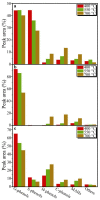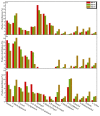Study on the Relationship between the Structure and Pyrolysis Characteristics of Lignin Isolated from Eucalyptus, Pine, and Rice Straw through the Use of Deep Eutectic Solvent
- PMID: 38202802
- PMCID: PMC10780212
- DOI: 10.3390/molecules29010219
Study on the Relationship between the Structure and Pyrolysis Characteristics of Lignin Isolated from Eucalyptus, Pine, and Rice Straw through the Use of Deep Eutectic Solvent
Abstract
Understanding the pyrolysis product distributions of deep eutectic solvent (DES)-isolated lignins (DESLs) from different types of biomass is of great significance for lignin valorization. The structure and pyrolysis properties of DESLs obtained from eucalyptus (E-DESL), pine (P-DESL), and rice straw (R-DESL) were studied through the use of various methods such as elemental analysis, GPC, HS-GC, and NMR techniques, and the pyrolysis characteristics and product distributions of the DESLs were also further investigated through the use of TGA, Py-GC/MS, and tubular furnace pyrolysis. DESLs with high purity (88.5-92.7%) can be efficiently separated from biomass while cellulose is retained. E-DESL has a relatively low molecular weight, and P-DESL has a relatively higher hydrogen-carbon effective ratio and a lower number of condensation structures. The Py-GC/MS results show that, during DESL pyrolysis, the monomeric aromatic hydrocarbons, p-hydroxyphenyl-type phenols, and catechol-type phenols are gradually released when the guaiacyl-type phenols and syringyl-type phenols decrease with the rising temperature. 4-methylguaiacol and 4-methylcatechol, derived from the guaiacyl-type structural units, are positively correlated with temperature, which causes a significant increase in products with a side-chain carbon number of 1 from P-DESL pyrolysis. 4-vinylphenol, as a representative product of the R-DESL, derived from p-hydroxyphenyl-type structural units, also gradually increased. In addition, the P-DESL produces more bio-oil during pyrolysis, while gases have the highest distribution in E-DESL pyrolysis. It is of great significance to study the characteristic product distribution of lignin isolated through the use of DES for lignin directional conversion into specific high-value aromatic compounds.
Keywords: deep eutectic solvent; lignin; molecular structure; phenolic compounds; pyrolysis.
Conflict of interest statement
The authors declare no conflicts of interest.
Figures







Similar articles
-
Fascinating polyphenol lignin extracted from sawdust via a green and recyclable solvent route.Int J Biol Macromol. 2023 Apr 15;234:123780. doi: 10.1016/j.ijbiomac.2023.123780. Epub 2023 Feb 21. Int J Biol Macromol. 2023. PMID: 36822281
-
Unveiling the Migration and Transformation Mechanism of Lignin in Eucalyptus During Deep Eutectic Solvent Pretreatment.ChemSusChem. 2022 Aug 5;15(15):e202200553. doi: 10.1002/cssc.202200553. Epub 2022 Jul 11. ChemSusChem. 2022. PMID: 35593890
-
Physicochemical Properties, Thermal Stability, and Pyrolysis Behavior of Antioxidative Lignin from Water Chestnut Shell Obtained with Ternary Deep Eutectic Solvents.Molecules. 2023 May 15;28(10):4088. doi: 10.3390/molecules28104088. Molecules. 2023. PMID: 37241829 Free PMC article.
-
Production of monomeric phenols by thermochemical conversion of biomass: a review.Bioresour Technol. 2001 Sep;79(3):277-99. doi: 10.1016/s0960-8524(00)00180-2. Bioresour Technol. 2001. PMID: 11499582 Review.
-
A review on lignin pyrolysis: pyrolytic behavior, mechanism, and relevant upgrading for improving process efficiency.Biotechnol Biofuels Bioprod. 2022 Oct 11;15(1):106. doi: 10.1186/s13068-022-02203-0. Biotechnol Biofuels Bioprod. 2022. PMID: 36221137 Free PMC article. Review.
References
-
- Bhatia S.K., Jagtap S.S., Bedekar A.A., Bhatia R.K., Rajendran K., Pugazhendhi A., Rao C.V., Atabani A.E., Kumar G., Yang Y.H. Renewable Biohydrogen Production from Lignocellulosic Biomass Using Fermentation and Integration of Systems with Other Energy Generation Technologies. Sci. Total Environ. 2021;765:144429. doi: 10.1016/j.scitotenv.2020.144429. - DOI - PubMed
-
- Yuan J.-M., Li H., Xiao L.-P., Wang T.-P., Ren W.-F., Lu Q., Sun R.-C. Valorization of lignin into phenolic compounds via fast pyrolysis: Impact of lignin structure. Fuel. 2022;319:123758. doi: 10.1016/j.fuel.2022.123758. - DOI
-
- Zhang X., Zhou Y., Xiong W., Wang P., Wei W., Ma J. Ex-situ catalytic microwave pyrolysis of alkali lignin facilitates the production of monophenols and monoaromatics under the application of LaFe1−xCuxO3 perovskites. Fuel. 2023;335:126987. doi: 10.1016/j.fuel.2022.126987. - DOI
-
- Chen S., Lu Q., Han W., Yan P., Wang H., Zhu W. Insights Into the Oxidation–Reduction Strategy for Lignin Conversion to High-Value Aromatics. Fuel. 2021;283:119333. doi: 10.1016/j.fuel.2020.119333. - DOI
-
- Dou Z., Zhang Z., Wang M. Self-Hydrogen Transfer Hydrogenolysis of Native Lignin Over Pd-PdO/TiO2. Appl. Catal. B-Environ. 2022;301:120767. doi: 10.1016/j.apcatb.2021.120767. - DOI
MeSH terms
Substances
Grants and funding
LinkOut - more resources
Full Text Sources
Miscellaneous

